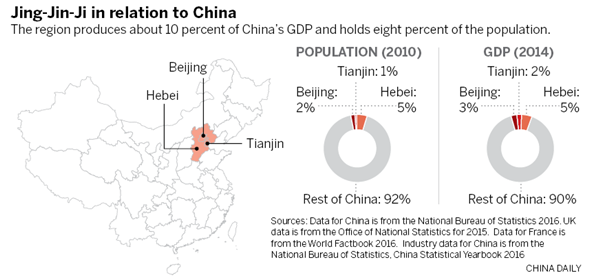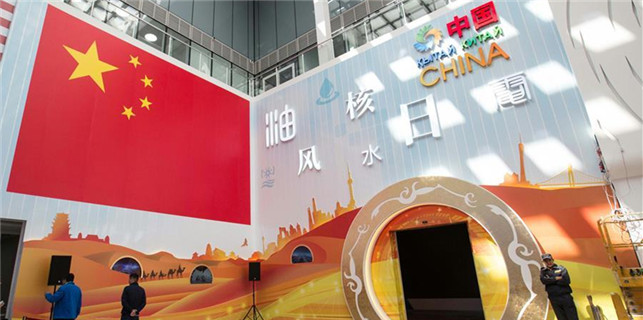New urban model

Transforming Hebei
Beijing and Tianjin are among China's toptier cities, but the surrounding province of Hebei remains less developed, with an economy based on high-polluting heavy industry. Hebei is the world's largest steel producer. It produces more steel than any single country globally. Steel, coal, cement, glass and other heavy construction-oriented industry accounts for roughly two-thirds of Hebei employment.
But, Liu Daizong, China Transport Program director at the World Resources Institute, says a bigger long-term pay off may arise from solving Hebei's development problem.
Wang Xiaodong, vice-governor of Hebei, said in June last year that the province aims to cut 49.9 million tons of iron-making capacity, 49.1 million metric tons of steel-making capacity and 51 million tons of coal production capacity under the province's 13th Five-Year Plan, as reported by The Economist. This helps solve industrial overcapacity problems, but what will the workers do?
Building infrastructure will create job opportunities and stimulate the economy. But the real payoff will come when the interconnectedness of the region allows people in Hebei to move up to higher value-added high-tech manufacturing or service jobs.
Henry Paulson, former US treasury secretary and former chairman of Goldman Sachs, said: "All eyes are on the Jing-Jin-Ji region as a testing ground for innovative solutions to China's complex sustainable development challenges.
"By concentrating investments in renewable energy sources and upgrading the energy efficiency of industry, Jing-Jin-Ji has the potential to play a tremendous leadership role in demonstrating how existing industries can become cleaner and more efficient, while also incubating new clean-energy technologies that are tomorrow's economic drivers," he said in a recent Paulson Institute report on China's sustainable economic transition.
Huang Wenzheng of the Center for China and Globalization emphasizes that Hebei's economy needs investment in education and increased opportunities for its people, at least as much as infrastructure.
"The key is the soft part, how do you treat people? Can they move? Can they send their children to a local school? China has much room for improvement in infrastructure. But, if it just uses a fraction of the money and puts it into schools, hospitals and day care centers, it would be much better for ordinary people's lives."
Xiongan as a model city
"Xiongan will be a new model for China's urbanization for the next 20 years," says Liu Daizong of the World Resources Institute. He says the China Academic Urban Planning and Design Institute, part of the Ministry of Housing and Urban-Rural Development, is widely consulting experts and no final plans have been made. However, he believes that Xiongan will be designed to the highest standards of urbanists worldwide to create a green and livable city.
"They want to use new urban planning principles — small roads and small districts, energy self-sufficiency, mixed-use areas balancing homes and jobs, multi modal transportation," Liu says.
"They also have some ideas to focus on smart-city technology and on integrating future innovation, such as driverless cars. They want to have ‘complete streets' that make space for pedestrians, bikes and buses. They are very close to Baiyangdian Lake, so they want to use sponge city technology to handle water runoff. They plan to have a 15-minute life cycle — meaning that residents can find everything they need for their daily lives within a 15-minute walk.
"They also are focused on connections to other cities, using high-speed rail or other modes. They have plans for connecting seamlessly to Beijing's airport. They also have a plan for cargo and freight. They want to have some freight rail corridors and multimodal integration — from trains to trucks to small vans."
Lu Huapu of Tsinghua University, who also is a member of the expert committee advising the coordinated development of the Beijing-Tianjin-Hebei region, told Xinhua News Agency:
"Transportation in the new area should mainly focus on rail and bus transit options, complemented by bike-sharing and other green, advanced and highly intelligent transportation options.
"Public transportation, parking, traffic management and logistics should all be supported by smart systems."
More broadly, China has changed its urban planning guidelines to increase the livability of all cities.
According to Barjor Mehta of the World Bank: "The new government guidelines specify smaller, walkable blocks that are not walled off. Under the old system, shops were all inside, which created dull streets. In the new guidelines, they advocate mixed residential and commercial areas with shops along sidewalks, so the streets are alive more hours in the day."
Nie Weihua, deputy dean of the National Academy of Development and Strategy at Renmin University of China, says Xiongan will be "a well planed city".
"Many State-owned enterprises, colleges, research institutions and hospitals are expected to go there. I think it may be a test of the new development model."
He adds: "It has not been decided yet, but the government may own all the housing and rent it to workers in the area in order to attract young knowledge workers. This is a lot like Hong Kong or Singapore."
















